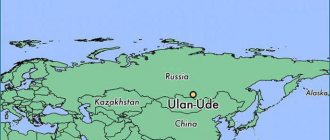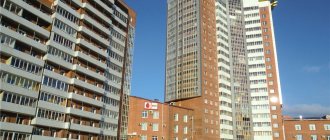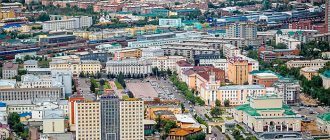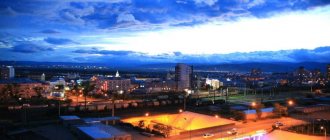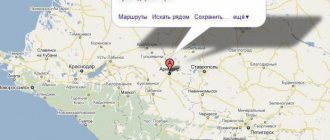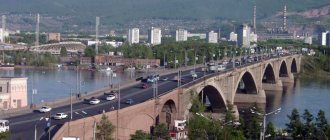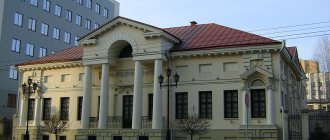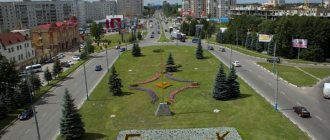Ulan-Ude, the third largest city in Eastern Siberia, was founded in 1666 as a Cossack winter hut. 20 years later, the royal ambassador left his retinue here and gave the village a name - Verkhneudinsk. The name Ulan-Ude, translated from Buryat as “red river,” was assigned to the city only in 1934.
In the 19th century, Ulan-Ude, close to China and Mongolia, became a major trading city, and it remained so in the 21st century.
The capital of Buryatia is the center of Russian Buddhism. Followers of Siddhartha Gautama peacefully coexist with Christians: there are equal numbers of datsans and Orthodox churches in the city.
Historical monuments of the 17th-19th centuries have been preserved in Ulan-Ude. And at the end of the 20th century, a tradition appeared in the city: every year a new attraction opens here.
From Ulan-Ude it is worth traveling through the amazingly beautiful surroundings - we have highlighted the most interesting places in Buryatia in this guide.
For ease of route planning, we have marked all the mentioned attractions on the city map:
Parks, streets and monuments
Arbat
Address: st. Lenina, 24
The only pedestrian street in the city was created by analogy with Moscow's Arbat. On the central street of Ulan-Ude there are sights from different times:
- Odigitrievsky Cathedral of 1741 - the first stone building of the city;
- Gostiny Dvor 1791;
- wooden arch 1891;
- cinema "Erdem" 1909;
- regional library 1925;
- Opera and Ballet Theater 1952;
- puppet theater "Ulger" 1967;
- merchant houses and shops of the 19th century.
The city's Arbat is paved, there is a fountain, and souvenir shops are open.
Theater Square and musical fountain
Address: st. Lenina, 51
The musical fountain is located next to the Opera and Ballet Theater. The building was opened in 2011, the area was equipped with a recreation area and a summer stage. Water jets “dance” to Buryat folk melodies and classical symphonies. In the evening, the musical accompaniment is complemented by color.
Victory Memorial Park
Address: st. Baltakhinova, 17
The park is dedicated to the city residents who died in the Great Patriotic War. In the center of the square there is a T-34 tank on a pedestal. Nearby are bronze portraits of Heroes of the Soviet Union.
The park has a small fountain, benches, and free Wi-Fi.
Triumphal Arch "Royal Gate"
Address: st. Lenin
The first “Royal Gate” was erected in honor of the arrival of Tsarevich Nikolai Alexandrovich in the city in 1891. The arch stood until 1917 and was destroyed by revolutionaries.
An exact copy of the decoration was built in 2006.
Monument to the Verkhneudinsk merchant
Address: st. Lenin
In 2012, a competition was held for the best project: the winner, Yuri Erdyneev, became the author of the monument.
It is believed that the object has no real prototype, but a merchant with the name engraved on the monument actually lived in Verkhneudinsk. Local residents say that the stone Evsey Lukich brings financial success.
Sculpture “The Rod of the God of Trade Mercury and the Cornucopia”
Address: st. Lenin
Back in 1790, Catherine II approved the city’s coat of arms: the rod of Mercury and the cornucopia, symbolizing prosperity. The sculpture dedicated to the coat of arms was built in 2004.
On the bronze horn there is a ball where tourists throw coins to return to Ulan-Ude. There is a fountain next to the composition and benches for relaxation.
Monument “Mother Buryatia”
Address: Selenginsky Bridge
The entirely bronze statue, created in 2002, can be seen from anywhere in the city. The height of the sculpture is 16 meters, the length of the outstretched arms is 6.
At the Selenginsky Bridge, before entering the city, the monument was erected only in 2008, by analogy with the location of the American Statue of Liberty. The sculpture symbolizes a Buryat woman.
Story
The founding of the city of Ulan-Ude is associated with the movement of Russian pioneers in the second half of the 17th century in Transbaikalia. In 1666, the Uda winter hut was founded by the leaders of the Cossacks - the Pentecostal Gavrila Lovtsov and the foreman Osip Vasiliev. In 1677-1680, the Udinsky fort was built in its place. In 1689, the okolnichy Fyodor Golovin signed the Treaty of Nerchinsk with China and founded a new fort - Udinsk. It protected from Mongol raids, and caravan trade passed through it. In 1735, the settlement was renamed Verkhneudinsk. In 1775 it received city status. In 1740-1785, the first stone building was erected in it - the Odigitrievsky Cathedral.
Odigitrievsky Cathedral.
The 19th century in the history of Verkhneudinsk was marked by the exile of the Decembrists and the appearance of the railway in 1895-1899. The Trans-Siberian Railway gave impetus to the development of the city, which is noticeable in the surviving buildings of the early 20th century. During the Civil War, Soviet power was first established in it, and from August 1918 to February 1920, the city was controlled by whites along with Japanese and American invaders. Also in 1920, Verkhneudinsk was the capital of the Far Eastern Republic for several months.
In 1923, the city became the capital of the Buryat-Mongolian Autonomous Soviet Socialist Republic, and in 1934 it was renamed Ulan-Ude. In the 1920-1930s it developed rapidly. In the pre-war years, higher educational institutions and museums of various profiles, a Buryat drama theater, a philharmonic society, a radio center, and new industrial enterprises were opened, including an aircraft plant - the pride of Transbaikalia.
In 1958, a tram was launched in the city, but a trolleybus and a children's railway, like in neighboring Chita and Irkutsk, never appeared. On the occasion of the 100th anniversary of V.I. Lenin, an unusual monument was founded in Ulan-Ude and unveiled in 1971 - the 7-meter head of Ilyich.
Now this is a specific landmark of Ulan-Ude, like other monuments to Lenin, of which there are at least seven in the city. In 1973, an open-air ethnographic museum of the peoples of Transbaikalia opened, and in the 2000s, a new building of the Russian Drama Theater and the local Arbat opened.
Lenin's head.
Churches, cathedrals and temples
Datsan Rinpoche Bagsha
Address: st. Streletskaya, 1 Phone: Website: https://yelo-rinpoche.ru/ Opening hours: 09.00-16.00 Mon-Sun Cost: free
Datsan opened in 2004 on the highest point of the city. The largest Buddhist bell in the country is installed on the territory of the temple; in the building itself there is a 6-meter statue of Buddha made of bronze. 8 stupas next to the datsan are a symbol of the wisdom of Siddhartha Gautama.
The park area of the temple is equipped with 12 gazebos made in the shape of animals of the eastern calendar. On the one kilometer long road of life there is a park of stones, the path is decorated with stands with excerpts from sacred texts.
The datsan houses a rosary weighing 350 kg, donated to the temple by the Japanese monk Hayashi Hiroshi.
Holy Hodegetrievsky Cathedral
Address: st. Lenina, 2 Phone: Website: https://uud.cerkov.ru/ Opening hours: 07.00-20.00 Mon-Sun Cost: free
The Orthodox church, built in 1785, is designed in the Siberian Baroque style. The cathedral was built in a zone of high seismic activity - the building was gradually destroyed by earthquakes. In 1929, the church decoration was finally destroyed by the Bolsheviks, and the temple was closed.
The restored cathedral reopened in 2001. A 100-pound bell was installed here, and the icons were painted anew by Buryat masters.
In 1996, the Ural icon of the Smolensk Mother of God Hodegetria was given to the temple; in 1999, the image streamed myrrh for 12 days.
Church of St. Nicholas the Wonderworker
Address: st. Revolution of 1905, 56a Phone: Website: https://www.uud-eparh.ru/index.php/2010-10-29-02-43-41/2010-10-29-02-49-10/2012 -08-27-02-20-04/92-2010-01-04-09-38-33 Opening hours: 07.30-19.00 Mon-Sun Cost: free
The wooden building next to the railway station was rebuilt at the beginning of the 20th century; in the 1930s, the temple was converted into a waiting room.
The new church was erected in 2005, the construction style is traditional: golden domes, white stone walls. The outside of the temple is decorated with icons.
Church of the Ascension of the Lord
Address: st. Proizvodstvennaya, 6 Telephone: Opening hours: 07.00-19.00 Mon-Sun Cost: free
The two-story wooden church was opened in the 18th century. At the beginning of the 20th century, the temple, which had become dilapidated, was repaired, but the entire building could not be saved - the second floor had to be demolished.
In 1929 the temple was closed and returned to believers after the Great Patriotic War, at which time a new iconostasis was created. During the Soviet era, the church was the only one operating in Buryatia. In the 1980s, the building was renovated, icon cases, a five-meter iconostasis, and candlesticks were made.
Sights of Ulan-Ude
Sights of Ulan-Ude. The most important and interesting sights of Ulan-Ude - photos and videos, descriptions and reviews, location, websites.
- New Year tours
to Russia - Last minute tours
to Russia
- Ulan-Ude, st. Kuibysheva, 38
Buryat Drama Theater
Ulan-Ude, st.
Kuibysheva, 38 State Buryat Academic Drama Theater named after. Khotsa Namsaraeva is the oldest in Buryatia, its history began in 1932. In Ulan-Ude, it is called the keeper of the national culture and language, since almost all performances (including world classics) are staged here in the Buryat language. - Ulan-Ude, st. Lenina, 51
Buryat Opera and Ballet Theater
Ulan-Ude, st.
Lenina, 51 The magnificent palace, which houses the opera and ballet theater, is one of the most recognizable symbols of Ulan-Ude. The building in the Stalinist Empire style with numerous elements characteristic of Buddhist religious architecture was erected in 1952 by Japanese prisoners of war. - Ulan-Ude, st. Sakhyanova, 8
Museum of the Buryat Scientific Center Soran
Ulan-Ude, st.
Sakhyanova, 8 The Mineralogical Museum is the only academic museum in Transbaikalia. The exhibition includes a rich collection of Buryat jades of various colors and shades, wonderful selections of decorative marble, landscape jasper, and various chalcedony. - fabulous
Ulan-Ude, st. Profsoyuznaya, 29
Museum of the History of Buryatia named after. Khangalova
great
1 reviewUlan-Ude, st. Profsoyuznaya, 29
The Museum of the History of Buryatia is one of the oldest in Siberia. The most interesting materials on archeology and religious cults (shamanism, Orthodoxy, Buddhism) are collected here. The museum's collection includes rare books and coins, a rich collection of Buddhist thangkas (icons). Exhibition of contemporary paintings and works of decorative and applied art.
- Ulan-Ude, st. Lenina, 26
Museum of History of Ulan-Ude
Ulan-Ude, st.
Lenina, 26 Despite the more than 300-year history of Ulan-Ude, the city museum was created relatively recently, in 2000. The municipality allocated the house of the merchant Goldobin, an outstanding philanthropist and honorary citizen, for it. - Ulan-Ude, st. Kuibysheva, 29
Museum of Nature of Buryatia
Ulan-Ude, st.
Kuibysheva, 29 The best way to get acquainted with the flora and fauna of Buryatia is to visit the Museum of Nature of the Republic. Now he has been forced to move to the building of the Art Museum. Sampilov, occupying a small room there. On an area of only 200 sq. m there are more than 400 exhibits. - Ulan-Ude, st. Lenina, 2
Odigitrievsky Cathedral in Ulan-Ude
Ulan-Ude, st.
Lenina, 2 In almost every ancient Russian city, one of the main architectural dominants is a large Orthodox church, which is in some way connected with its history. Ulan-Ude is no exception, although the capital of Buryatia also reflects the presence of other religious cultures. - Ulan-Ude, pl. Soviets
Monument to Lenin in Ulan-Ude
Ulan-Ude, pl.
Soviet Central Square with the Lenin monument installed on it is a typical picture for many Russian cities. But the monument to the leader of the world proletariat in Ulan-Ude breaks all stereotypes. On the Square of the Soviets there is... a giant head of Ilyich. - Ulan-Ude, st. Streletskaya, 1
Rinpoche-Bagsha
Ulan-Ude, st.
Streletskaya, 1 For the indigenous population of Buryatia, Buddhist monasteries-datsans have always been and remain centers of spiritual life, education and traditional medicine. On the outskirts of Ulan-Ude, where the mountain range begins, a new Buddhist church was built in 2000. - Ulan-Ude, st. Sverdlova, 6B/2
Puppet theater "Ulger"
Ulan-Ude, st.
Sverdlova, 6B/2 “Ulger” is the only children’s theater in Buryatia. It received its name in honor of the Uligers - ancient folk tales in the genre of heroic-historical epic. It mainly stages performances based on national folklore, but the playbill includes Buryat plays side by side with classical fairy tales. - Ulan-Ude, st. Kuibysheva, 37
Trinity Church in Ulan-Ude
Ulan-Ude, st.
Kuibysheva, 37 The history of the Holy Trinity Church began in 1770 with a small wooden church. At the beginning of the 19th century, through the efforts of local merchants Vasily Pakholkov and Afanasy Nalyotov, the Orthodox shrine received a stone building. Up until the 1930s. Mostly funeral services were held in the church - it stood in the center of the cemetery. - below the average
Ulan-Ude, village. Verkhnyaya Berezovka st. Museum, 17b
Ethnographic Museum of the Peoples of Transbaikalia in Ulan-Ude
below average
5 reviewsUlan-Ude, village. Verkhnyaya Berezovka st. Museum, 17b
The Ethnographic Museum of the Peoples of Transbaikalia is an open-air museum complex in the near suburb of Ulan-Ude, a picturesque area of the Verkhnyaya Berezovka microdistrict. One of the largest open-air museums in Russia, it was opened in mid-summer 1973.
- Ulan-Ude, village. Verkhnyaya Berezovka
Ethnographic Museum of Ulan-Ude
Ulan-Ude, village.
Upper Berezovka The open-air museum, located in the near suburbs, houses several interesting historical objects related to the life and culture of the peoples of Transbaikalia. Traditional dwellings, tools and household items of the peoples of Transbaikalia are of great interest to visitors.
The main attractions of Ulan-Ude are located in the city center.
Unfortunately, most of them have long been in need of major repairs, but some are quite well preserved. On the banks of the Uda and Selenga rivers there are still old merchant mansions from the Classical era, which are today recognized as monuments of wooden architecture. Many, including modern buildings, are decorated with national ornaments, mosaics, panels and stained glass windows. There are a lot of different monuments in the city. This is due to the fact that giving a monument to the city on a birthday is a long-standing local tradition. There is a singing fountain, chess kings and local pride - the world's largest monument to Lenin in the central city square, Soviet Square.
The most famous landmark of Ulan-Ude is the monument to Lenin on Soviet Square. This leader's head weighs 42 tons and is the largest monument to Vladimir Ilyich in the world.
The population of Ulan-Ude is multinational and professes different religions. There are a lot of Buddhists in this city, you can easily meet shamans on the street, but the most famous temple is the Orthodox one. Odigitrievsky Cathedral on the banks of the Uda is the very first stone building in the city. Its facades are designed in the Siberian Baroque style: the platbands and other details are very carefully drawn.
The Odigitrievsky Cathedral is also curious because it was built in a zone of seismic activity: exactly in the very place where the Uda River flows into the Selenga.
As for Buddhist monuments, they appeared in the city relatively recently: in 1994 the datsan Khambyn Khure was built, in 2000 - the women's datsan Zungon Darzhaling, and in 2002 - the Buddhist center Rimpoche Bagsha.
In the suburbs of Ulan-Ude there is a very interesting open-air ethnographic museum of the peoples of Transbaikalia. The exhibition of the museum complex tells about the life and everyday life of local indigenous settlements from the beginning of the 19th century. The museum also has its own zoo, where animals typical of Transbaikalia live: bears, wolves, deer, roe deer and camels.
Entertainment
Tourist complex "Steppe Nomad"
Address: st. Babushkina, 164 Phone: Website: https://etnoatsagat.ru/ Opening hours: 09.00-18.00 Mon-Sun Cost: from 500 rubles
The complex is located near the sacred Mount Tamkhita in the Atsagat Valley. The doctors of the local datsan treated the royal persons. People from all over the world came to Lamas Choinzon Iroltuev and Agvan Dorzhiev in the 19th century for healing.
“Steppe Nomad” introduces tourists to the Buryat culture and traditions of the people. Complex services:
- culinary master classes on preparing national dishes;
- walking and horseback excursions;
- accommodation in a real yurt;
- archery training;
- participation in national games;
- the ability to care for camels and horses;
- master class on Buryat dances.
A stream flows through the complex, there is a vegetable garden, and there is a sauna and bathhouse.
Attractions in the surrounding area
Lake Baikal
GPS coordinates: 53.5149078, 108.1054688
Ulan-Ude is located near the eastern coast of the lake: here Baikal is shallower than on other sides. In summer, the weather in the area is sunny, there are sandy beaches on the shore, recreation centers and hotels operate.
The road from Posolsky Sor to Chivyrkuisky Bay is considered one of the best for relaxing on Lake Baikal and exploring the sights.
You can read more about Baikal in these articles:
- Which Baikal resort to choose for a holiday with children?
- What attractions are there around Baikal and on Olkhon Island
- How and when to travel wild
Ivolginsky datsan “Khambyn Sume”
Address: s. Verkhnyaya Ivolga, st. Dorozhnaya Phone: Website: https://sangharussia.ru/ Opening hours: 09.00-18.00 Mon-Fri, Sat-Sun - days off Cost: free How to get there: route No. 108 from the stop. Verkhnyaya Berezovka in Ulan-Ude
The first service in the largest datsan of Buryatia was held in 1945, by 1972 the main Cathedral Church was completely rebuilt. On the territory of “Khambyn Sume” there are:
- library;
- Buddhist University;
- souvenir rows;
- museum;
- sacred stupas;
- Green Tara is a stone that fulfills good wishes.
The main shrine of the datsan is the burial place of Dasha-Dorzho Itigelov, who predicted the onset of atheism and revolution.
In 1927, the head of Russian Buddhism fell into nirvana, but bequeathed to dig up his body after 70 years. The elder’s wish was fulfilled; decades later Itigelov retained the signs of a living person: no decay, a whole nose and eyeballs, movable joints, warm skin. No explanation has been found for the miracle; scientists put forward only hypotheses.
If you have not yet chosen where you will live and want to save money when booking, we recommend using the RoomGuru service. Firstly, it contains hotels, apartments and guest houses from many different booking systems, so you won’t miss out on a worthwhile option. Secondly, you can immediately compare prices for one place in different services and book where it is cheaper (this is not always Booking!).
Day 1
You can get from the airport to the city by taxi "Maxim" or "Yandex". You can even catch a car on the spot: 300 rubles for a half-hour trip. People travel around the city itself mainly by minibuses (fare: 20 rubles). There is even a tram in Ulan-Ude, but it mainly connects the new industrial part, the part with new buildings, and the historical center.
If you want to rent a car, keep in mind that most cars are brought here from Japan, and therefore they are right-hand drive.
Walk around the city
You should start getting acquainted with Ulan-Ude from Soviet Square, where, without exaggeration, the main attraction of the city is located - the 7-meter head of Lenin weighing 42 tons - the largest in the country. Among the people, the “head” serves as a landmark and meeting place. From here it is also convenient to go on a city tour. Pay attention to the local architecture, rich in authentic historical details such as wooden houses with architraves and shutters that stand untouched and dilapidated.
Dinner
Get ready that there is almost no traditional Russian food in Ulan-Ude, and why have it when you can and should try Buryat food - fatty, filling and cheap. Take the analogue of khinkali - buuzy (or poses), bantan (Mongolian soup with lamb) and tea, which is drunk here with milk.
200 rubles
"Buuza Room" - st. Lenina, 52
Walk along the local Arbat
Pedestrian wide street with lots of advertising. You can look into Gostiny Ryad, Kirov Square, Oreshkov Park and City Garden. For a change, it’s worth visiting the Museum of the History of Buryatia (Profsoyuznaya St., 29) with a large archaeological and Buddhist collection. The most valuable exhibit is considered to be the “Atlas of Tibetan Medicine” - a monument of fine art and a source for studying the medieval culture of the Buddhist world.
Dinner
Shulen - noodle soup with beef from 90 rubles. Tsuivan (fried Uzbek noodles with beef and vegetables) - 120 rubles. Tea with milk - 20 rubles. Dessert: boovs - 40 rubles.
240 rubles
"ShulenDo" - st. Kommunisticheskaya, 22
